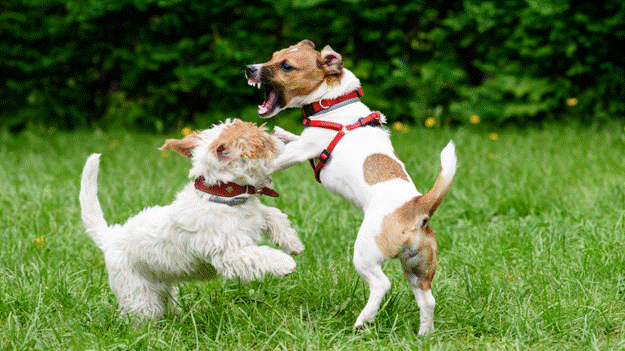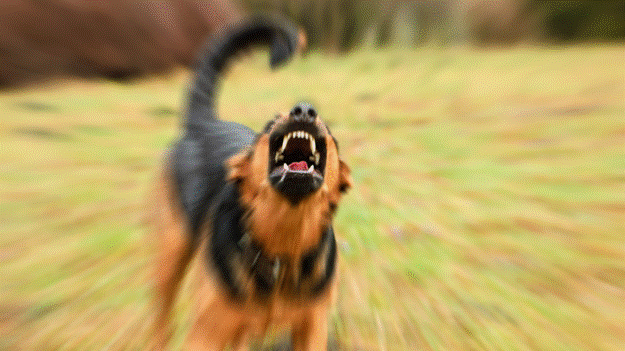How to Deal with an Aggressive Dog?
Dealing with your dog’s behavioral issues is a stressful task already, and having an aggressive dog is even more challenging. One should know how to deal with an aggressive dog. It isn’t just an issue of being worried about the aggressive pet or having to arrange a wrecked living room.
An aggressive dog can land you in big trouble if someone is attacked or bitten. Aggression in dogs is a significant problem that pet owners face from time to time and remain clueless about dealing with it. Even though the issue is a complex one, it can be greatly improved.
What Is Dog Aggression?
Aggression refers to a wide range of violent behaviors that may occur due to several reasons, depending on the circumstances. Usually, an attack is an indication that the dog is unhappy, scared, or emotionally disturbed. Aggressive behavior may also be a result of some trigger.
What you must understand is that aggression among dogs isn’t just about biting or attacking someone. It can have many different forms and can mean other things. Some canines can keep their aggression subdued and only act out with an occasional growl. However, some cannot handle aggression well and can attack other animals or people.
No matter how your dog displays aggressive behavior, the primary aspect to focus on is to understand what triggers this behavior. Knowing the underlying cause behind dog aggression will make treatment more effective and less complicated.
Is There a Link between Dog Breed and Aggression?
There is no such scientifically proven connection between breed and dog aggression. Most of the time, people blame the breed for their dog’s unpleasant or unacceptable behavior, particularly for the bigger dogs. However, it is just a myth because any breed can cause issues if a trigger is there.
Hence, it is a misperception that a Chihuahua will never display aggressive behavior, and a Pit Bull will always be confrontational. Violent behavior is totally unrelated to the dog breed. But, we cannot ignore the fact that a bigger dog will cause bigger damage. Perhaps, this is the only difference between dog breeds. Strong and powerful breeds like the Cane Corso, Pit Bull, or the Mastiff can cause severe damage when they become violent compared to smaller breeds.
Signs of Aggressive Behaviors in Dogs
It is crucial to identify when a dog is on the verge of being aggressive or is about to attack. There are specific signs and body language indicators that are usually a precursor to an attack. If you can learn to interpret the signs of aggressive behavior, it will become easier to deal with the issue in time. Except for the Sudden Onset of Aggression syndrome, a rare condition that triggers aggressive actions, you can predict your dog’s likeliness to become aggressive with the following signs:
- Stiffness of body posture
- Pinned back ears
- Teeth baring and growling
- Bites of varying intensity
- Snarling
Causes of Aggression
Remember that it is rare for a dog to display violent behavior without any reason. Therefore, you must find out what’s making your dog aggressive and how to deal with an aggressive dog. Usually, it is a lack of appropriate training or socialization, but there can be many other causes contributing to this condition. Some of the more common causes of violent behaviors among dogs include:
Possession Aggression/Food Aggression
It is also called resource guarding. Possession aggression typically involves a dog’s obsessive behavior towards particular objects like their bed, favorite toy, or food. If someone (a person or a pet) approaches that object, the dog will react violently. This type of aggression is most common among territorial dogs, especially when an intruder enters their turf. Depending on the situation, dogs can respond with growling or launching a full-fledged attack.
Fear Aggression
Fear is a powerful motivating factor not just for humans but dogs as well. Whenever your canine faces a fearful situation, a nervous dog will indulge in a flight or fight response, and an aggressive dog will choose to attack. Unfortunately, there aren’t any warning signs for fear aggression as it is like a defense mechanism. However, generally fear aggression is a result of past trauma.
Leash Aggression
If your pet remains calm and friendly most of the time and suddenly starts barking, lunging, or attempts to bits you when you put on their leash, this indicates leash aggression. This behavior stems from your puppy’s frustration as they feel restrained by their leash.

Social Aggression
Domineering dogs like to remind everyone, especially the weaker dogs, about who’s the real boss. They achieve this by displaying aggressive behaviors. Sometimes, such dogs may lash out at people if they feel they are runt. It happens because dogs like to move around in packs and tend to behave like a leader. So, always try to be assertive and act like a pack leader to keep them docile.
Pain-induced Aggression
Generally, dogs are capable of hiding their pain successfully. However, if they are dealing with unbearable pain or something is bothering them a lot, they will express it through nipping/growling. Injured dogs are most likely to bite or attack their owners when they try to help.
Risk Factors
If you think that it is okay to allow your dog to be aggressive rather than getting it treated, think again because there are several adverse consequences associated with it. As a pet parent, you will be held responsible for your dog’s behavior and any subsequent damages that may occur.
If your dog has a biting habit, be prepared to deal with unnecessary financial losses as such dogs are considered risky and an insurance liability. Aggressive dogs are at a higher risk of euthanizing, especially dogs with unpredictable behavior and those that give little to no warning signs before attempting to bite someone.

What do you do if an off-leash dog approaches you while you are walking a dog?
How to Treat Aggression in Dogs?
There’s no doubt that dogs’ aggressive behavior is a complex issue, and there’s no easy fix available. Nothing can turn your beloved canine into a well-behaved pup overnight. If the aggression reaches severe stages, it will become even harder to handle the dog. However, with the right approach, patience, and treatment, it is possible to stop dog aggression at its earlier stages. In this regard, only a professional trainer can help you out.
As a professional dog trainer, I can quickly identify whether it is some stressor that makes your furball enraged or whether the aggression stems from past trauma. If your dog has suddenly started showing aggressiveness, this could also be a signal of pain. However, without adequate understanding, you cannot identify why your dog is behaving aggressively. Only a professional trainer can determine the actual cause of your pet’s violent behavior and suggest an effective treatment.
It is important to note that with all behavioral issues, prevention is fundamental. Behavior modification techniques are not just humane but quite effective in treating violent behaviors in dogs. Do consult me when your dog displays any signs of aggression to nip the issue in the bud.
I will develop a comprehensive treatment plan customized according to the dog’s temperament and your situation.
Dog aggression is indeed a severe behavioral issue; it still is just an issue that can be corrected in most of the dogs with the right approach.
